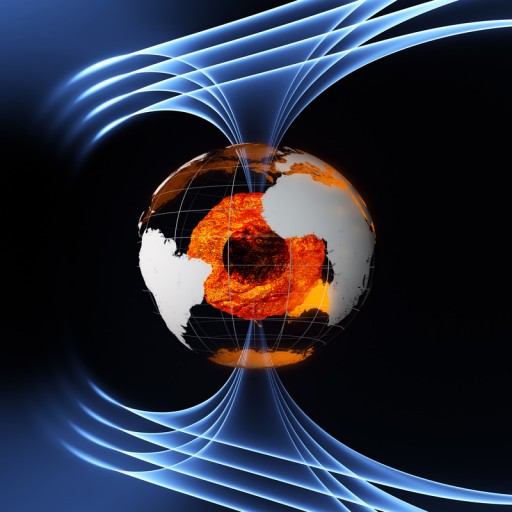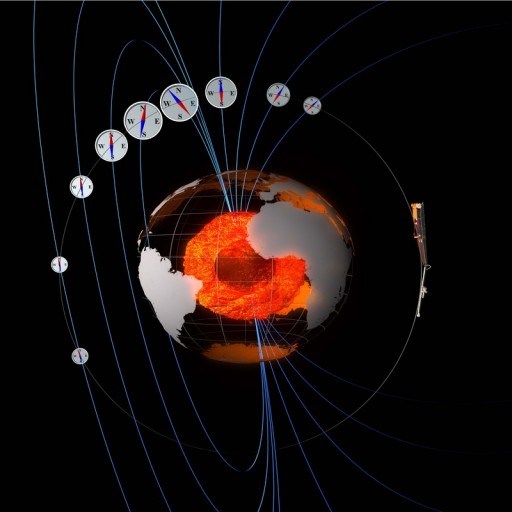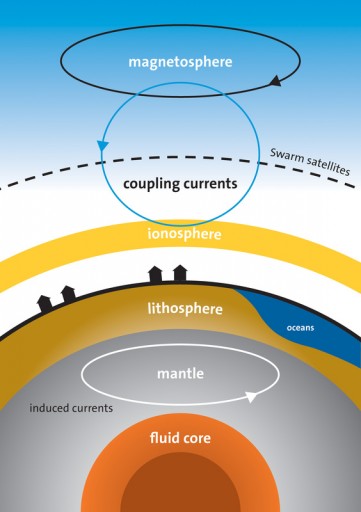Swarm – Science Overview

Swarm will follow a number of missions that mapped the magnetic field of the Earth from a low orbit including NASA’s MagSat launched in 1979, the German CHAMP satellite launched in 2000 and the Argentinean SAC-C satellite also launched in 2000. But all those missions were single satellite missions. Swarm is the first mission to send three spacecraft into LEO in order to provide data from several points in space for measurements at unprecedented spatial and temporal resolution.
The primary objective of the Swarm mission is to provide the best survey of the geomagnetic field with multi-point measurements enabling the examination of the magnetic field’s temporal evolution to gain new insights into the Earth system, improving the understanding of the planet’s interior and climate.
Earth’s magnetic field can be described as a centered dipole field with its axis offset from Earth’s rotation axis by an angle of 11.5 degrees that shows temporal variations as a result of movement in the core of the Earth. The magnetic field lines run between the magnetic north and south poles of Earth. At these points, the lines lie vertical to the surface of Earth. The magnetic north and south poles wander independently and are not located directly opposite of each other on the globe. At random intervals of several hundred thousand years, the two poles reverse, changing places with each other. The magnetic field at any given location can be represented by a three-dimensional vector.
Earth’s magnetic field is caused by the dynamo effect (geodynamo) that is generated by movements in Earth’s core. Liquid iron in the outer core acts as a rotating, convecting, and electrically conducting fluid that maintains a magnetic field on astronomic time scales. The rotation of the outer core is supplied by the Coriolis effect that itself is caused by the rotation of the Earth. Earth’s magnetic field is rather weak at 25,000 to 65,000 nanotesla.
Despite being relatively weak, the Earth’s magnetic field is of great importance as it protects the planet from from the solar wind and cosmic radiation, creating a magnetosphere that surrounds the Earth. Interacting with charged particles to deflect the solar wind is important as the solar wind could strip away the ozone layer and Earth’s atmosphere, leading to an increased amount of ultraviolet and cosmic radiation reaching the surface. The solar wind can distort Earth’s magnetic field.
Earth’s magnetic field shows numerous anomalies from the ideal properties of a centered bar magnet. These anomalies can be very large and affect entire regions of the planet such as the South Atlantic Anomaly in which aircraft as well as orbiting satellites are exposed to more intense solar and cosmic radiation.
The Swarm mission will study a number of primary and secondary research topics:
- Core dynamics, geodynamo processes and core–mantle interaction.
- Magnetism of the lithosphere and its geological context.
- 3D electrical conductivity of the mantle related to composition.
- Magnetic signature related to ocean circulation.
- Analyzing electric currents in magnetosphere and ionosphere.
- Understanding the impact of solar wind on dynamics of the upper atmosphere.

Swarm will study planetary core dynamics, geodynamic processes and core-mantle interactions – seeking to improve the models of the core field dynamics by making long-term measurements with high spatial and temporal resolution. Using data from previous missions, Swarm observations will allow the investigation of all magnetohydrodynamic phenomena potentially affecting the core on sub-annual to decadal time scales.
Also, Swarm will examine lithospheric magnetization. Swarm’s high-resolution enables the identification of the oceanic magnetic stripes corresponding to periods of reversing magnetic polarity. Plate tectonics in the oceanic lithosphere in the Southern Ocean is poorly understood because of limited data coverage of previous missions. Swarm provides a global map of lithospheric magnetization at improved resolution that can provide global maps of heat flux.
Swarm also makes measurements of the three-dimensional electrical conductivity of the mantle. These measurements will lead to a better understanding of chemical and physical properties of the mantle. Currently, geomagnetic observatories are dispersed sparsely across the globe with very few in oceanic regions. Swarm can provide measurements on a global scale to accurately determine mantel conductivity.

The three Swarm satellites conduct simultaneous measurements of the currents flowing in the magnetosphere and ionosphere at different altitudes and local times. This provides a better separation of internal and external sources which will significantly improve geomagnetic field models. External field contributions are of great interest for space weather research while internal field modeling is also able to benefit from Swarm data. The local time distribution of measurements will allow the development of new methods of estimating internal and external contributions.
With its highly sensitive instruments, Swarm can identify and measure the magnetic signature of ocean circulation that produces a magnetic field that is of interest to scientists as direct detections can help improve circulation and conductivity models.
The geomagnetic field controls the dynamics of the ionized and neutral particles in the upper atmosphere of Earth with a potential effect on the lower atmosphere as well. Equipped with a dedicated set of instruments, Swarm will make in-situ measurements of the interacting field and particles at high-resolution. Measurements include ion speed, direction and energy.
Ion density and winds around a single satellite can be derived by looking at data from each satellite. Combining satellite data allows a new way of quantifying currents that flow along geomagnetic field lines. Those measurements will help understand the dynamic processes that are ongoing in the near-Earth environment. Studying the energy input into the magnetosphere can provide new information on space weather phenomena, their formation and prediction.
